【狂神说Java】Mybatis最新完整教程IDEA版通俗易懂
Mybatis 笔记及源码
Mybatis 中文文档
Mybatis 案例源码
狂神说——Mybatis 学习
Mybatis-9.28 学习准备环境: JDK1.8、Mysql 5.7、maven 3.6.1、IDEA
简介
什么是Mybatis
- MyBatis 是一款优秀的持久层框架
- 它支持定制化 SQL、存储过程以及高级映射。
- MyBatis 避免了几乎所有的 JDBC 代码和手动设置参数以及获取结果集。
- MyBatis 可以使用简单的 XML 或注解来配置和映射原生类型、接口和 Java 的 POJO(Plain Old Java Objects,普通老式 Java 对象)为数据库中的记录。
- MyBatis 本是apache的一个开源项目iBatis, 2010年这个项目由apache software foundation 迁移到了google code,并且改名为MyBatis 。
- 2013年11月迁移到Github。
如何获得Mybatis?
<!-- https://mvnrepository.com/artifact/org.mybatis/mybatis -->
<dependency>
<groupId>org.mybatis</groupId>
<artifactId>mybatis</artifactId>
<version>3.5.2</version>
</dependency>
持久化
数据持久化
- 持久化就是将程序的数据在持久状态和瞬时状态转化的过程
- 内存:断电即失
- 数据库(Jdbc),io文件持久化。
- 生活:冷藏. 罐头。
为什么需要需要持久化?
-
有一些对象,不能让他丢掉。
-
内存太贵了
持久层
Dao层,Service层,Controller层….
- 完成持久化工作的代码块
- 层界限十分明显。
为什么需要Mybatis?
- 帮助程序猿将数据存入到数据库中。
- 方便
- 传统的JDBC代码太复杂了。简化。框架。自动化。
- 不用Mybatis也可以。更容易上手。 技术没有高低之分
- 优点:
- 简单易学
- 灵活
- sql和代码的分离,提高了可维护性。
- 提供映射标签,支持对象与数据库的orm字段关系映射
- 提供对象关系映射标签,支持对象关系组建维护
- 提供xml标签,支持编写动态sql。
最重要的一点:使用的人多!
Spring SpringMVC SpringBoot
第一个Mybatis程序(CRUD)
思路:搭建环境–>导入Mybatis–>编写代码–>测试!
搭建环境
数据库
CREATE DATABASE `hhmybatis`;
USE `hhmybatis`;
CREATE TABLE `user`(
`id` INT(20) NOT NULL PRIMARY KEY,
`name` VARCHAR(30) DEFAULT NULL,
`pwd` VARCHAR(30) DEFAULT NULL
)ENGINE=INNODB DEFAULT CHARSET=utf8;
INSERT INTO `user`(`id`,`name`,`pwd`) VALUES
(1,'狂神','123456'),
(2,'张三','123456'),
(3,'李四','123890')
新建项目:
新建一个普通的maven项目,删除src目录,导入maven依赖
mybatis-01 pom.xml
<!--导入依赖-->
<dependencies>
<!--mysql驱动-->
<dependency>
<groupId>mysql</groupId>
<artifactId>mysql-connector-java</artifactId>
<version>5.1.47</version>
</dependency>
<!--mybatis 依赖-->
<dependency>
<groupId>org.mybatis</groupId>
<artifactId>mybatis</artifactId>
<version>3.5.7</version>
</dependency>
<!-- lombok 实体类会用到注解引用的包 -->
<dependency>
<groupId>org.projectlombok</groupId>
<artifactId>lombok</artifactId>
<version>1.18.22</version>
<!-- <scope>provided</scope>-->
</dependency>
<!--junit 测试会用到的 -->
<dependency>
<groupId>junit</groupId>
<artifactId>junit</artifactId>
<version>4.13.2</version>
<!--<scope>test</scope>-->
</dependency>
</dependencies>
<!-- 在build中配置resources,来防止我们资源导出失败的问题 -->
<build>
<!-- maven资源没有导出问题 java.io.IOException: Could not find resource mybatis-config.xml -->
<resources>
<resource>
<directory>src/main/resources</directory>
<includes>
<include>**/*.properties</include>
<include>**/*.xml</include>
</includes>
<filtering>true</filtering>
</resource>
<resource>
<directory>src/main/java</directory>
<includes>
<include>**/*.properties</include>
<include>**/*.xml</include>
</includes>
<filtering>true</filtering>
</resource>
</resources>
<!-- Failed to execute goal org.apache.maven.plugins:maven-surefire-plugin:2.12.4:test -->
<plugins>
<plugin>
<groupId>org.apache.maven.plugins</groupId>
<artifactId>maven-surefire-plugin</artifactId>
<version>2.4.2</version>
<configuration>
<skipTests>true</skipTests>
</configuration>
</plugin>
</plugins>
</build>
创建一个模块
编写mybatis的核心配置文件:mybatis-config.xml
<?xml version="1.0" encoding="UTF-8" ?>
<!DOCTYPE configuration
PUBLIC "-//mybatis.org//DTD Config 3.0//EN"
"http://mybatis.org/dtd/mybatis-3-config.dtd">
<!--configuration核心配置文件-->
<configuration>
<environments default="development">
<environment id="development">
<transactionManager type="JDBC"/>
<dataSource type="POOLED">
<property name="driver" value="com.mysql.jdbc.Driver"/>
<property name="url"
value="jdbc:mysql://localhost:3306/hhmybatis?useSSL=true&useUnicode=true&characterEncoding=UTF-8"/>
<property name="username" value="root"/>
<property name="password" value="123456"/>
</dataSource>
</environment>
</environments>
<!-- 每一个Mapper.XML都需要在Mybatis核心配置文件中注册
如果没有注册就使用会报org.apache.ibatis.binding.BindingException
-->
<mappers>
<mapper resource="com/hh/dao/UserMapper.xml"/>
</mappers>
</configuration>
添加工具类:MybatisUtils
package com.hh.utils;
import org.apache.ibatis.io.Resources;
import org.apache.ibatis.session.SqlSession;
import org.apache.ibatis.session.SqlSessionFactory;
import org.apache.ibatis.session.SqlSessionFactoryBuilder;
import java.io.IOException;
import java.io.InputStream;
//工具类 获取 sqlSessionFactory --> sqlSession
public class MybatisUtils {
//提升作用域
private static SqlSessionFactory sqlSessionFactory;
static{
try {
//使用Mybatis第一步:获取sqlSessionFactory对象
String resource = "mybatis-config.xml";
InputStream inputStream = Resources.getResourceAsStream(resource);
sqlSessionFactory = new SqlSessionFactoryBuilder().build(inputStream);
// SqlSessionFactory sqlSessionFactory = new SqlSessionFactoryBuilder().build(inputStream);// NullPointerException,没有注册到资源!
} catch (IOException e) {
e.printStackTrace();
}
}
//既然有了 SqlSessionFactory,顾名思义,我们就可以从中获得 SqlSession 的实例了。
// SqlSession 完全包含了面向数据库执行 SQL 命令所需的所有方法。
public static SqlSession getSqlSession(){
// SqlSession sqlSession = sqlSessionFactory.openSession();
// return sqlSession;
return sqlSessionFactory.openSession();
}
}
编写代码
User实体类
package com.hh.pojo;
//实体类
public class User {
private int id;
private String name;
private String pwd;
//alt+insert
public User() {
}
public User(int id, String name, String pwd) {
this.id = id;
this.name = name;
this.pwd = pwd;
}
public int getId() {
return id;
}
public void setId(int id) {
this.id = id;
}
public String getName() {
return name;
}
public void setName(String name) {
this.name = name;
}
public String getPwd() {
return pwd;
}
public void setPwd(String pwd) {
this.pwd = pwd;
}
@Override
public String toString() {
return "User{" +
"id=" + id +
", name='" + name + '\'' +
", pwd='" + pwd + '\'' +
'}';
}
}
Dao接口:UserMapper
package com.hh.dao;
import com.hh.pojo.User;
import java.util.List;
import java.util.Map;
/*
Map传递参数,直接在sql中取出key即可! 【parameterType="map"】
对象传递参数,直接在sql中取对象的属性即可!【parameterType="Object"】
只有一个基本类型参数的情况下,可以直接在sql中取到!
多个参数用Map,或者注解!
*/
//专用的是 XXXMap 例如:UserMapper 等同于以前常用的 UserDao
public interface UserMapper {
/**
* 模糊查询 List<User> userList = mapper.getUserLike("%李%");
* @return
*/
List<User> getUserLike(String value);
/**
* 获取全部查询用户
* @return 查询所有用户
*/
List<User> getUserList();
/**
* 获取ID查询用户
* @param id
* @return 查询id用户
*/
User getUserById(int id);
User getUserById2(Map<String, Object> map);
/**
* insert 一个用户
* @param user
* @return 插入是否成功
*/
int addUser(User user);
/**
* 万能的map 假设,我们的实体类,或者数据库中的表,字段或者参数过多,我们应当考虑使用Map!
* @param map
* @return
*/
int addUser2(Map<String, Object> map);
/**
* 修改用户
* @param user
* @return 修改是否成功
*/
int updateUser(User user);
/**
* 删除一个用户
* @param id
* @return
*/
int deleteUser(int id);
}
接口实现类由原来的UserDaoImpl转变为一个 Mapper配置文件
UserMapper.xml
<?xml version="1.0" encoding="UTF-8" ?>
<!DOCTYPE mapper
PUBLIC "-//mybatis.org//DTD Mapper 3.0//EN"
"http://mybatis.org/dtd/mybatis-3-mapper.dtd">
<!-- namespace中的包名要和 Dao/mapper 接口的包名一致!-->
<mapper namespace="com.hh.dao.UserMapper">
<!--
id是否可以相同主要看namespace,同一个不能
id : 就是对应的namespace中的方法名; UserMapper
resultType:Sql语句执行的返回值!
parameterType : 参数类型!
-->
<!--模糊查询 select * from hhmybatis.user where name like "%"#{value}"%" -->
<select id="getUserLike" resultType="com.hh.pojo.User">
select * from hhmybatis.user where name like #{value};
</select>
<!--select查询语句-->
<select id="getUserList" resultType="com.hh.pojo.User">
select * from hhmybatis.user
</select>
<!--g根据id查询-->
<select id="getUserById" parameterType="int" resultType="com.hh.pojo.User">
select * from hhmybatis.user where id = #{id}
</select>
<select id="getUserById2" parameterType="map" resultType="com.hh.pojo.User">
select * from hhmybatis.user where id = #{hid} and name=#{hname};
</select>
<!-- 对象中的属性,可以提取出来 -->
<insert id="addUser" parameterType="com.hh.pojo.User">
insert into hhmybatis.user (id, name, pwd) values (#{id},#{name},#{pwd});
</insert>
<!-- 对象中的属性,可以提取出来
传递map的key
-->
<insert id="addUser2" parameterType="map">
insert into hhmybatis.user (id, name, pwd) values (#{userid},#{userName},#{password});
</insert>
<!--修改-->
<update id="updateUser" parameterType="com.hh.pojo.User">
update hhmybatis.user set name = #{name}, pwd = #{pwd} where id = #{id};
</update>
<!--删除-->
<delete id="deleteUser" parameterType="int">
delete from hhmybatis.user where id = #{id};
</delete>
</mapper>
测试
注意点:增删改需要提交事务!
UserMapperTest:
package com.hh.dao;
import com.hh.pojo.User;
import com.hh.utils.MybatisUtils;
import org.apache.ibatis.session.SqlSession;
import org.junit.Test;
import java.util.HashMap;
import java.util.List;
import java.util.Map;
public class UserMapperTest {
//测试模糊查询
@Test
public void getUserLike() {
SqlSession sqlSession = MybatisUtils.getSqlSession(); //第一步:获得SqlSession对象
UserMapper mapper = sqlSession.getMapper(UserMapper.class); //方式一:getMapper
List<User> userLike = mapper.getUserLike("%李%");
for (User user : userLike) {
System.out.println(user);
}
sqlSession.close();
}
@Test
public void test(){
//第一步:获得SqlSession对象
SqlSession sqlSession = MybatisUtils.getSqlSession();
//方式一:getMapper
UserMapper userMapper = sqlSession.getMapper(UserMapper.class);
List<User> userList = userMapper.getUserList();
//方式二:
// List<User> userList = sqlSession.selectList("com.hh.dao.UserMapper.getUserList");
for (User user : userList) {
System.out.println(user);
}
//关闭SqlSession
sqlSession.close();
}
@Test
public void getUserById() {
//第一步:获得SqlSession对象
SqlSession sqlSession = MybatisUtils.getSqlSession();
UserMapper mapper = sqlSession.getMapper(UserMapper.class);
User user = mapper.getUserById(1);
System.out.println(user);
sqlSession.close();
}
@Test
public void getUserById2() {
//第一步:获得SqlSession对象
SqlSession sqlSession = MybatisUtils.getSqlSession();
UserMapper mapper = sqlSession.getMapper(UserMapper.class);
Map<String, Object> map = new HashMap<String, Object>();
map.put("hid", 5);
map.put("hname", "哈行昂");
//注意:查询语句有几个参数map就需要put几个参数,这里存在两个参数只写一个会返回 null 值
User user = mapper.getUserById2(map);
System.out.println(user);
sqlSession.close();
}
// *****增删改查需要【提交事务】
@Test
public void addUser() {
SqlSession sqlSession = MybatisUtils.getSqlSession();
UserMapper mapper = sqlSession.getMapper(UserMapper.class);
int i = mapper.addUser(new User(4, "哈哈", "123123"));
if (i > 0) {
System.out.println("插入成功");
}
sqlSession.commit();//提交事务 (不提交事务的话会显示插入成功但是数据库会没有数据)
sqlSession.close();//关闭sqlSession
}
@Test
public void addUser2() {
SqlSession sqlSession = MybatisUtils.getSqlSession();
UserMapper mapper = sqlSession.getMapper(UserMapper.class);
Map<String, Object> map = new HashMap<String, Object>();
map.put("userid", 6);
map.put("userName", "哈行昂");
map.put("password", "465789");
int i = mapper.addUser2(map);
if (i > 0) {
System.out.println("插入成功");
}
sqlSession.commit();//事务提交
sqlSession.close();
}
/*
addUser2 运行遇到的异常
注意:在id已经存在的前提下再次新增id重复的数据就会报这个异常
或者id设置自增的,这里给添加了id的也会报如下异常
org.apache.ibatis.exceptions.PersistenceException:
### Error updating database. Cause: com.mysql.jdbc.exceptions.jdbc4
.MySQLIntegrityConstraintViolationException: Duplicate entry '5' for key 'PRIMARY'
*/
@Test
public void updateUser() {
SqlSession sqlSession = MybatisUtils.getSqlSession();
UserMapper mapper = sqlSession.getMapper(UserMapper.class);
int i = mapper.updateUser(new User(4, "呵呵", "123123"));
if (i > 0) {
System.out.println("修改成功");
}
sqlSession.commit();//提交事务
sqlSession.close();//关闭 sqlSession
}
@Test
public void deleteUser() {
SqlSession sqlSession = MybatisUtils.getSqlSession();
UserMapper mapper = sqlSession.getMapper(UserMapper.class);
int i = mapper.deleteUser(6);
if (i > 0) {
System.out.println("删除成功");
}
sqlSession.commit();//提交事务
sqlSession.close();
}
}
万能的Map
假设,我们的实体类,或者数据库中的表,字段或者参数过多,我们应当考虑使用Map!
int addUser2(Map<String, Object> map);
Map传递参数,直接在sql中取出key即可! 【parameterType="map"】
<insert id="addUser2" parameterType="map">
insert into hhmybatis.user (id, name, pwd) values (#{userid},#{userName},#{password});
</insert>
对象传递参数,直接在sql中取对象的属性即可!【parameterType="Object"】
只有一个基本类型参数的情况下,可以直接在sql中取到!
多个参数用Map,或者注解!
模糊查询
模糊查询怎么写?
Java代码执行的时候,传递通配符 % %
List<User> userList = mapper.getUserLike("%李%");
在sql拼接中使用通配符!
select * from mybatis.user where name like "%"#{value}"%"
注意可能遇到的问题
- 配置文件没有注册
- 绑定接口错误。
- 方法名不对
- 返回类型不对
- Maven导出资源问题
- 标签不要匹配错
- resource 绑定mapper,需要使用路径!
- 程序配置文件必须符合规范!
- NullPointerException,没有注册到资源!
- 输出的xml文件中存在中文乱码问题!
配置解析
核心配置文件mybatis-config.xml
MyBatis 的配置文件包含了会深深影响 MyBatis 行为的设置和属性信息。
configuration(配置)
properties(属性)
settings(设置)
typeAliases(类型别名)
typeHandlers(类型处理器)
objectFactory(对象工厂)
plugins(插件)
environments(环境配置)
environment(环境变量)
transactionManager(事务管理器)
dataSource(数据源)
databaseIdProvider(数据库厂商标识)
mappers(映射器)
环境配置
MyBatis 可以配置成适应多种环境
不过要记住:尽管可以配置多个环境,但每个 SqlSessionFactory 实例只能选择一种环境。
学会使用配置多套运行环境!
Mybatis默认的事务管理器就是 JDBC , 连接池 : POOLED
属性配置(properties)
在核心配置文件中,属性配置是一大难点,我们可以通过properties属性来实现引用配置文件
这些属性都是可外部配置且可动态替换的,既可以在典型的 Java 属性文件中配置,亦可通过 properties 元素的子元素来传递。【db.properties】
编写一个配置文件:db.properties
driver=com.mysql.jdbc.Driver
url=jdbc:mysql://localhost:3306/hhmybatis?useSSL=true&useUnicode=true&characterEncoding=UTF-8
username=root
password=123456
在核心配置文件中引入
<!--引入外部配置文件-->
<properties resource="db.properties"/>
<!--引入外部配置文件 写法2:-->
<!--<properties resource="db.properties">
<!–这里面的等同于 db.properties里面的 username=root pwd=123456 优先级1–>
<property name="username" value="root"/>
<property name="pwd" value="123456"/> 优先级1
</properties>-->
- 可以直接引入外部文件
- 可以在其中增加一些属性配置
- 如果两个文件有同一个字段,优先使用外部配置文件的!
类型别名(typeAliases)
- 类型别名是为 Java 类型设置一个短的名字。‘
- 存在的意义仅在于用来减少类完全限定名的冗余。
也可以指定一个包名,MyBatis 会在包名下面搜索需要的 Java Bean,比如:
扫描实体类的包,它的默认别名就为这个类的 类名,首字母小写!
<!--可以给实体类起别名-->
<typeAliases>
<package name="com.kuang.pojo"/>
</typeAliases>
在实体类比较少的时候,使用第一种方式。
如果实体类十分多,建议使用第二种。
第一种可以DIY别名,第二种则·不行·,如果非要改,需要在实体上增加注解
@Alias("user")
public class User {}
设置
这是 MyBatis 中极为重要的调整设置,它们会改变 MyBatis 的运行时行为。

其他配置
- typeHandlers(类型处理器)
- objectFactory(对象工厂)
- plugins插件
- mybatis-generator-core
- mybatis-plus
- 通用mapper
映射器(mappers)
MapperRegistry:注册绑定我们的Mapper文件;
方式一: 【推荐使用】
<!--每一个Mapper.XML都需要在Mybatis核心配置文件中注册!-->
<mappers>
<mapper resource="com/kuang/dao/UserMapper.xml"/>
</mappers>
方式二:使用class文件绑定注册
<!--每一个Mapper.XML都需要在Mybatis核心配置文件中注册!-->
<mappers>
<mapper class="com.kuang.dao.UserMapper"/>
</mappers>
注意点:
- 接口和他的Mapper配置文件必须同名!
- 接口和他的Mapper配置文件必须在同一个包下!
方式三:使用扫描包进行注入绑定
<!--每一个Mapper.XML都需要在Mybatis核心配置文件中注册!-->
<mappers>
<package name="com.kuang.dao"/>
</mappers>
注意点:
- 接口和他的Mapper配置文件必须同名!
- 接口和他的Mapper配置文件必须在同一个包下!
练习时间:
- 将数据库配置文件外部引入
- 实体类别名
- 保证UserMapper 接口 和 UserMapper .xml 改为一致!并且放在同一个包下!
生命周期和作用域

生命周期,和作用域,是至关重要的,因为错误的使用会导致非常严重的并发问题。
SqlSessionFactoryBuilder:
一旦创建了 SqlSessionFactory,就不再需要它了
局部变量
SqlSessionFactory:
说白了就是可以想象为 :数据库连接池
SqlSessionFactory 一旦被创建就应该在应用的运行期间一直存在,没有任何理由丢弃它或重新创建另一个实例。
因此 SqlSessionFactory 的最佳作用域是应用作用域。
最简单的就是使用单例模式或者静态单例模式。
SqlSession
连接到连接池的一个请求!
SqlSession 的实例不是线程安全的,因此是不能被共享的,所以它的最佳的作用域是请求或方法作用域。
用完之后需要赶紧关闭,否则资源被占用!
这里面的每一个Mapper,就代表一个具体的业务!
解决属性名和字段名不一致的问题
数据库的字段名称和实体类字段名称不一致的问题

解决:
在核心配置文件mybatis-config.xml给实体类起别名
<!-- 可以给实体类起别名 【默认别名为类名的小写:也就是 user】-->
<typeAliases>
<typeAlias type="com.hh.pojo.User" alias="User"/> <!-- 实体类比较少的时候,使用。 可以DIY别名-->
<!-- <package name="com.hh.pojo"/>-->
<!--实体类十分多的时候使用,如果想要DIY别名可以在实体上增加注解 例如:@Alias("hello")-->
</typeAliases>
UserMapper.xml
<!--结果集映射 column数据库中的字段,property实体类中的属性 -->
<resultMap id="UserMap" type="User">
<!--一样的可以不写,column数据库中的字段,property实体类中的属性
<result column="id" property="id"/>
<result column="name" property="name"/>-->
<result column="pwd" property="password"/>
</resultMap>
<!--根据id查询 select id,name,pwd as password from hhmybatis.user where id = #{id} -->
<select id="getUserById" resultMap="UserMap">
select * from hhmybatis.user where id = #{id}
</select>
- resultMap 元素是 MyBatis 中最重要最强大的元素
- ResultMap 的设计思想是,对于简单的语句根本不需要配置显式的结果映射,而对于复杂一点的语句只需要描述它们的关系就行了。
- ResultMap 最优秀的地方在于,虽然你已经对它相当了解了,但是根本就不需要显式地用到他们。
日志
日志工厂
如果一个数据库操作,出现了异常,我们需要排错。日志就是最好的助手!
曾经:sout 、debug
现在:日志工厂!

SLF4J、LOG4J 【开发常用,掌握】、LOG4J2、JDK_LOGGING、COMMONS_LOGGING、STDOUT_LOGGING 【标准日志输出,掌握】、NO_LOGGING
在Mybatis中具体使用那个一日志实现,在设置中设定!
不导包的异常:Caused by: java.lang.ClassNotFoundException: org.apache.log4j.Priority
<!-- log4j 日志打印 -->
<dependency>
<groupId>log4j</groupId>
<artifactId>log4j</artifactId>
<version>1.2.17</version>
</dependency>
配置log4j.properties:
#将等级为DEBUG的日志信息输出到console和file这两个目的地,console和file的定义在下面的代码
log4j.rootLogger=DEBUG,console,file
#控制台输出的相关设置
log4j.appender.console = org.apache.log4j.ConsoleAppender
log4j.appender.console.Target = System.out
log4j.appender.console.Threshold=DEBUG
log4j.appender.console.layout = org.apache.log4j.PatternLayout
log4j.appender.console.layout.ConversionPattern=[%c]-%m%n
#文件输出的相关设置
log4j.appender.file = org.apache.log4j.RollingFileAppender
#日志输入保存
log4j.appender.file.File=./log/hh.log
log4j.appender.file.MaxFileSize=10mb
log4j.appender.file.Threshold=DEBUG
log4j.appender.file.layout=org.apache.log4j.PatternLayout
log4j.appender.file.layout.ConversionPattern=[%p][%d{yy-MM-dd HH:mm:ss}][%c]%m%n
#日志输出级别
log4j.logger.org.mybatis=DEBUG
log4j.logger.java.sql=DEBUG
log4j.logger.java.sql.Statement=DEBUG
log4j.logger.java.sql.ResultSet=DEBUG
log4j.logger.java.sql.PreparedStatement=DEBUG
在mybatis核心配置文件中,配置我们的日志!
<settings>
<!-- log4j 使用前一定要导包 (注意导包、大小写、空格)
value="STDOUT_LOGGING":标准日志输出,不需要配置 log4j.properties
value="LOG4J":自定义日志格式需要配置 log4j.properties
logImpl (该名称一定不能够写错!!!)
指定 MyBatis 所用日志的具体实现,未指定时将自动查找。
-->
<setting name="logImpl" value="LOG4J"/>
</settings>
注意:留空格异常:Caused by: java.lang.ClassNotFoundException: Cannot find class: LOG4J
<setting name="logImpl" value="LOG4J "/>
鼠标移到报错行尾部会发现有个空格
解决:直接去掉空格就好
Log4j
什么是Log4j?
- Log4j是Apache的一个开源项目,通过使用Log4j,我们可以控制日志信息输送的目的地- 是控制台、文件、GUI组件
- 我们也可以控制每一条日志的输出格式;
- 通过定义每一条日志信息的级别,我们能够更加细致地控制日志的生成过程。
- 通过一个配置文件来灵活地进行配置,而不需要修改应用的代码。
简单使用:
- 在要使用Log4j 的类中,导入包 import org.apache.log4j.Logger;
- 日志对象,参数为当前类的class
static Logger logger = Logger.getLogger(UserDaoTest.class); - 日志级别
logger.info("info:进入了testLog4j"); logger.debug("debug:进入了testLog4j"); logger.error("error:进入了testLog4j");
分页
为什么要分页? ----------------减少数据的处理量
Limit分页
语法:
SELECT * from user limit startIndex,pageSize;
SELECT * from user limit 3; #[0,n]
UserMapper接口:mybatis04 案例
//分页
List<User> getUserByLimit(Map<String,Integer> map);
UserMapper.xml:
<!--分页1 select * from hhmybatis.user limit ?,?-->
<select id="getUserByLimit" parameterType="map" resultMap="UserMap">
select * from hhmybatis.user limit #{startIndex},#{pageSize}
</select>
测试:
//使用Limit分页
@Test
public void getUserByLimit(){
SqlSession sqlSession = MybatisUtils.getSqlSession();
UserMapper mapper = sqlSession.getMapper(UserMapper.class);
HashMap<String, Integer> map = new HashMap<String, Integer>();
// 从索引为1开始 查询两条数据
map.put("startIndex",1);
map.put("pageSize",2);
List<User> userList = mapper.getUserByLimit(map);
for (User user : userList) {
System.out.println(user);
}
sqlSession.close();
}
RowBounds分页
不再使用SQL实现分页
UserMapper接口:
//分页2
List<User> getUserByRowBounds();
UserMapper.xml:
<select id="getUserByRowBounds" resultMap="UserMap">
select * from hhmybatis.user
</select>
测试:
//RowBounds分页 不再使用SQL实现分页
@Test
public void getUserByRowBounds(){
SqlSession sqlSession = MybatisUtils.getSqlSession();
//RowBounds实现 从索引为0开始 查询两条数据
RowBounds rowBounds = new RowBounds(0, 2);
//通过Java代码层面实现分页
List<User> userList = sqlSession.selectList("com.hh.dao.UserMapper.getUserByRowBounds",null,rowBounds);
for (User user : userList) {
System.out.println(user);
}
sqlSession.close();
}
分页插件分页
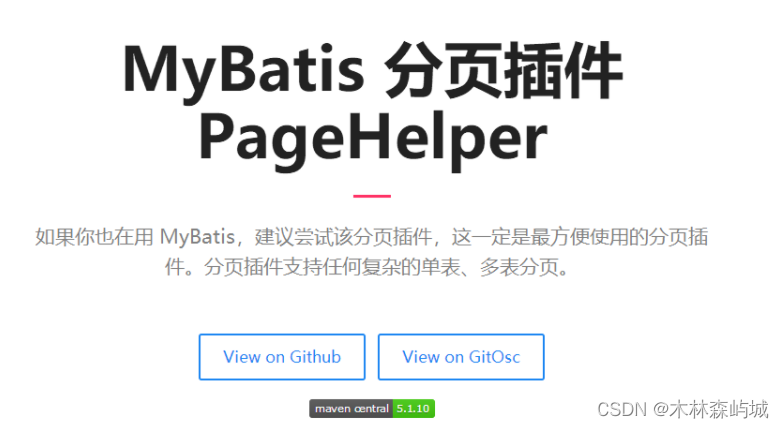
了解即可,万一 以后公司的架构师,说要使用,你需要知道它是什么东西!
使用注解开发
面向接口编程
大家之前都学过面向对象编程,也学习过接口,但在真正的开发中,很多时候我们会选择面向接口编程
-
根本原因 : 解耦 , 可拓展 , 提高复用 , 分层开发中 , 上层不用管具体的实现 , 大家都遵守共同的标准 , 使得开发变得容易 , 规范性更好
-
在一个面向对象的系统中,系统的各种功能是由许许多多的不同对象协作完成的。在这种情况下,各个对象内部是如何实现自己的,对系统设计人员来讲就不那么重要了;
-
而各个对象之间的协作关系则成为系统设计的关键。小到不同类之间的通信,大到各模块之间的交互,在系统设计之初都是要着重考虑的,这也是系统设计的主要工作内容。面向接口编程就是指按照这种思想来编程。
关于接口的理解
- 接口从更深层次的理解,应是定义(规范,约束)与实现(名实分离的原则)的分离。
- 接口的本身反映了系统设计人员对系统的抽象理解。
- 接口应有两类:
- 第一类是对一个个体的抽象,它可对应为一个抽象体(abstract class);
- 第二类是对一个个体某一方面的抽象,即形成一个抽象面(interface);
- 一个体有可能有多个抽象面。抽象体与抽象面是有区别的。
三个面向区别
- 面向对象是指,我们考虑问题时,以对象为单位,考虑它的属性及方法 . (DOM、 BOM)
- 面向过程是指,我们考虑问题时,以一个具体的流程(事务过程)为单位,考虑它的实现 .
- 接口设计与非接口设计是针对复用技术而言的,与面向对象(过程)不是一个问题.更多的体现就是对系统整体的架构
使用注解开发
- 注解在接口上实现
@Select("select * from user")
List<User> getUsers();
- 需要再核心配置文件中绑定接口!
<!--绑定接口-->
<mappers>
<mapper class="com.kuang.dao.UserMapper"/>
</mappers>
- 测试
本质:反射机制实现
底层:动态代理!

Batista详细的执行流程!

CRUD
案例:mybatis05
实体类User:
package com.hh.pojo;
//实体类
//@Alias("hello")
import lombok.AllArgsConstructor;
import lombok.Data;
import lombok.NoArgsConstructor;
@Data
@AllArgsConstructor
@NoArgsConstructor
public class User {
private int id;
private String name;
private String pwd;//数据库pwd
}
工具类 MybatisUtils:【我们可以在工具类创建的时候实现自动提交事务!】
package com.hh.utils;
import org.apache.ibatis.io.Resources;
import org.apache.ibatis.session.SqlSession;
import org.apache.ibatis.session.SqlSessionFactory;
import org.apache.ibatis.session.SqlSessionFactoryBuilder;
import java.io.IOException;
import java.io.InputStream;
//工具类 获取 sqlSessionFactory --> sqlSession
public class MybatisUtils {
//提升作用域
private static SqlSessionFactory sqlSessionFactory;
static{
try {
//使用Mybatis第一步:获取sqlSessionFactory对象
String resource = "mybatis-config.xml";
InputStream inputStream = Resources.getResourceAsStream(resource);
sqlSessionFactory = new SqlSessionFactoryBuilder().build(inputStream);
} catch (IOException e) {
e.printStackTrace();
}
}
public static SqlSession getSqlSession(){
//true 填写之后CRUP就不需要再写提交事务的代码了
return sqlSessionFactory.openSession(true);
}
}
接口UserMapper:
package com.hh.dao;
import org.apache.ibatis.annotations.*;
import com.hh.pojo.User;
import java.util.List;
/*
关于@Param() 注解
基本类型的参数或者String类型,需要加上
引用类型不需要加
如果只有一个基本类型的话,可以忽略,但是建议大家都加上!
我们在SQL中引用的就是我们这里的 @Param() 中设定的属性名!
#{} ${} 区别
*/
public interface UserMapper {
//【注意:我们必须要将接口注册绑定到我们的核心配置文件中! mybatis-config.xml 】
//1.注解在接口上实现
@Select("select * from user")
List<User> getUsers();//查询所有的用户
// 方法存在多个参数,所有的参数前面必须加上 @Param("xxx")注解 注意:一致的是 #{id} @Param("id")
@Select("select * from user where id = #{id}")
User getUserByID(@Param("id") int id);
//#{pwd}跟实体类里面的名称一致
@Insert("insert into user(id,name,pwd) values (#{id},#{name},#{pwd})")
int addUser(User user);
@Update("update user set name=#{name},pwd=#{pwd} where id = #{id}")
int updateUser(User user);
@Delete("delete from user where id = #{uid}")
int deleteUser(@Param("uid") int id);
}
核心配置文件 mybatis-config.xml:
<?xml version="1.0" encoding="UTF-8" ?>
<!DOCTYPE configuration
PUBLIC "-//mybatis.org//DTD Config 3.0//EN"
"http://mybatis.org/dtd/mybatis-3-config.dtd">
<!--configuration核心配置文件-->
<configuration>
<!--引入外部配置文件-->
<properties resource="db.properties"/>
<settings>
<!--STDOUT_LOGGING:标准日志格式 -->
<setting name="logImpl" value="STDOUT_LOGGING"/>
</settings>
<!-- 可以给实体类起别名 -->
<typeAliases>
<typeAlias type="com.hh.pojo.User" alias="User"/>
</typeAliases>
<environments default="development">
<environment id="development">
<!--事务管理器:transactionManager -->
<transactionManager type="JDBC"/>
<!-- 数据源:dataSource -->
<dataSource type="POOLED">
<property name="driver" value="${driver}"/>
<property name="url" value="${url}"/>
<property name="username" value="${username}"/>
<property name="password" value="${password}"/>
</dataSource>
</environment>
</environments>
<!--2.需要再核心配置文件中绑定接口!-->
<mappers>
<mapper class="com.hh.dao.UserMapper"/>
<!-- <mapper resource="com/hh/dao/*Mapper.xml"/> -->
</mappers>
</configuration>
测试类UserMapperTest:
package com.hh.dao;
import org.apache.ibatis.session.SqlSession;
import org.junit.Test;
import com.hh.pojo.User;
import com.hh.utils.MybatisUtils;
import java.util.List;
public class UserMapperTest {
@Test
public void test(){
//(SqlSessionFactoryBuilder)MybatisUtils——(sqlSessionFactory)getSqlSession
// ——getMapper——getUsers
SqlSession sqlSession = MybatisUtils.getSqlSession();
//底层主要应用反射
UserMapper mapper = sqlSession.getMapper(UserMapper.class);
List<User> users = mapper.getUsers();
for (User user : users) {
System.out.println(user);
}
sqlSession.close();
}
@Test
public void testUserByID(){
SqlSession sqlSession = MybatisUtils.getSqlSession();
UserMapper mapper = sqlSession.getMapper(UserMapper.class);
System.out.println(mapper.getUserByID(1));
sqlSession.close();
}
@Test
public void testaddUser(){
SqlSession sqlSession = MybatisUtils.getSqlSession();
UserMapper mapper = sqlSession.getMapper(UserMapper.class);
int i = mapper.addUser(new User(4, "haha", "123456"));
if (i>0){
System.out.println("新增用户成功^_^!");
}
// return sqlSessionFactory.openSession(true);后不需要提交事务了
// sqlSession.commit();//提交事务
sqlSession.close();
}
@Test
public void testupdateUser(){
SqlSession sqlSession = MybatisUtils.getSqlSession();
UserMapper mapper = sqlSession.getMapper(UserMapper.class);
int i = mapper.updateUser(new User(4, "呵呵", "123456"));
if (i>0){
System.out.println("修改用户成功 ^_^!");
}
sqlSession.close();
}
@Test
public void testdeleteUser(){
SqlSession sqlSession = MybatisUtils.getSqlSession();
UserMapper mapper = sqlSession.getMapper(UserMapper.class);
mapper.deleteUser(4);
sqlSession.close();
}
}
关于@Param() 注解
- 基本类型的参数或者String类型,需要加上
- 引用类型不需要加
- 如果只有一个基本类型的话,可以忽略,但是建议大家都加上!
- 我们在SQL中引用的就是我们这里的 @Param() 中设定的属性名!
#{} ${} 区别
mybatis 为我们提供了两种支持动态 sql 的语法:#{} 以及 ${}。
1)#{}是预编译处理,$ {}是字符串替换。
2)mybatis在处理#{}时,会将sql中的#{}替换为?号,调用PreparedStatement的set方法来赋值;mybatis在处理 $ { } 时,就是把 ${ } 替换成变量的值。
3)使用 #{} 可以有效的防止SQL注入,提高系统安全性。
拓展lombok
Project Lombok是一个java库,它可以自动插入编辑器和构建工具,增加java的趣味性。
可以不需要再写另一个getter或equals方法,只需一个注释,你的类就有了一个功能齐全的构建器,自动化你的日志变量,等等。
使用步骤:
-
在IDEA中安装Lombok插件!
-
在项目中导入lombok的jar包
<!-- lombok 实体类会用到注解引用的包 --> <dependency> <groupId>org.projectlombok</groupId> <artifactId>lombok</artifactId> <version>1.18.22</version> <!-- <scope>provided</scope>--> </dependency>-
在实体类上加注解即可!
@Data //无参构造,get、set、tostring、hashcode,equals @AllArgsConstructor //有参构造 @NoArgsConstructor //无参构造
-
上面的案例User实体类就是用了这个
实体类上还可以添加其他注解:
@Getter and @Setter
@FieldNameConstants
@ToString
@EqualsAndHashCode
@AllArgsConstructor, @RequiredArgsConstructor and @NoArgsConstructor
@Log, @Log4j, @Log4j2, @Slf4j, @XSlf4j, @CommonsLog, @JBossLog, @Flogger
@Data
@Builder
@Singular
@Delegate
@Value
@Accessors
@Wither
@SneakyThrows
多对一处理和一对多处理
解析
多个学生,对应一个老师
对于学生这边而言, 关联 … 多个学生,关联一个老师 【多对一】
对于老师而言, 集合 , 一个老师,有很多学生 【一对多】

准备表:
CREATE TABLE `teacher` (
`id` INT(10) NOT NULL,
`name` VARCHAR(30) DEFAULT NULL,
PRIMARY KEY (`id`)
) ENGINE=INNODB DEFAULT CHARSET=utf8
INSERT INTO teacher(`id`, `name`) VALUES (1, '秦老师');
CREATE TABLE `student` (
`id` INT(10) NOT NULL,
`name` VARCHAR(30) DEFAULT NULL,
`tid` INT(10) DEFAULT NULL,
PRIMARY KEY (`id`),
KEY `fktid` (`tid`),
CONSTRAINT `fktid` FOREIGN KEY (`tid`) REFERENCES `teacher` (`id`)
) ENGINE=INNODB DEFAULT CHARSET=utf8
INSERT INTO `student` (`id`, `name`, `tid`) VALUES ('1', '小明', '1');
INSERT INTO `student` (`id`, `name`, `tid`) VALUES ('2', '小红', '1');
INSERT INTO `student` (`id`, `name`, `tid`) VALUES ('3', '小张', '1');
INSERT INTO `student` (`id`, `name`, `tid`) VALUES ('4', '小李', '1');
INSERT INTO `student` (`id`, `name`, `tid`) VALUES ('5', '小王', '1');
多对一
环境搭建
案例mybatis06:(MybatisUtils工具类上面有)
-
导入lombok
<dependency> <groupId>org.projectlombok</groupId> <artifactId>lombok</artifactId> <version>1.18.22</version> </dependency> -
新建实体类 Teacher,Student
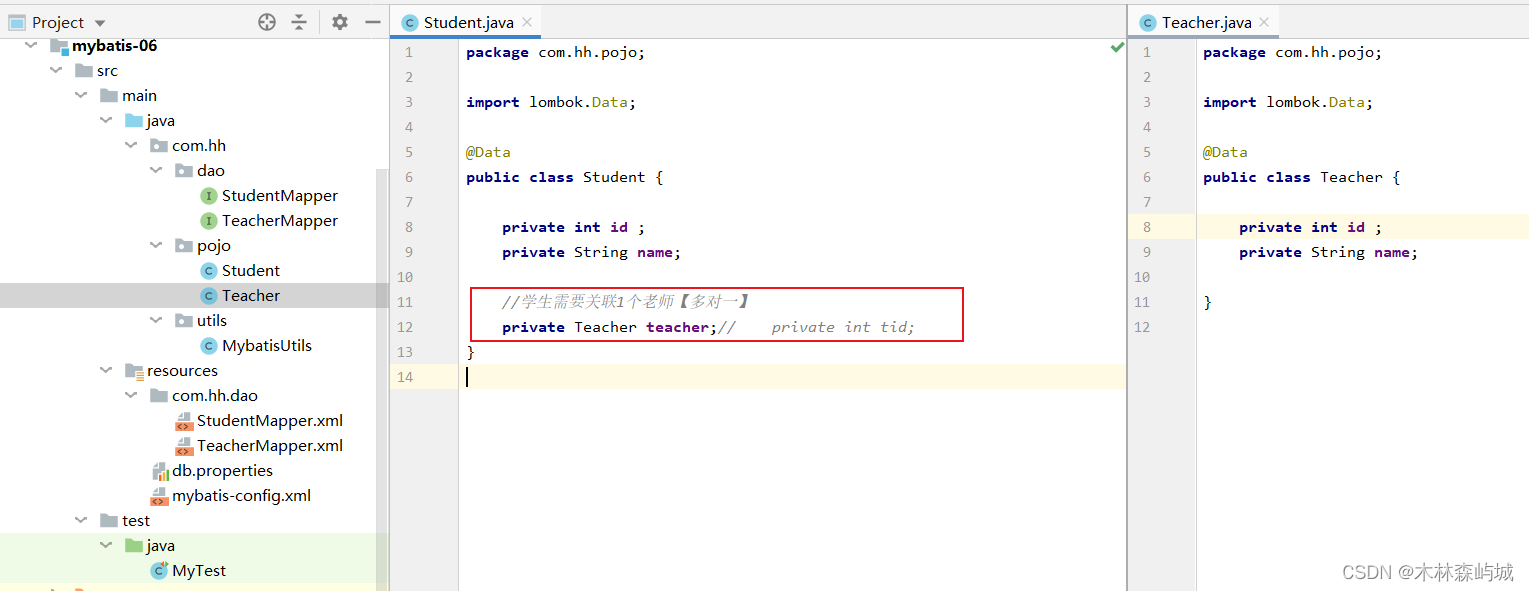
-
建立Mapper接口
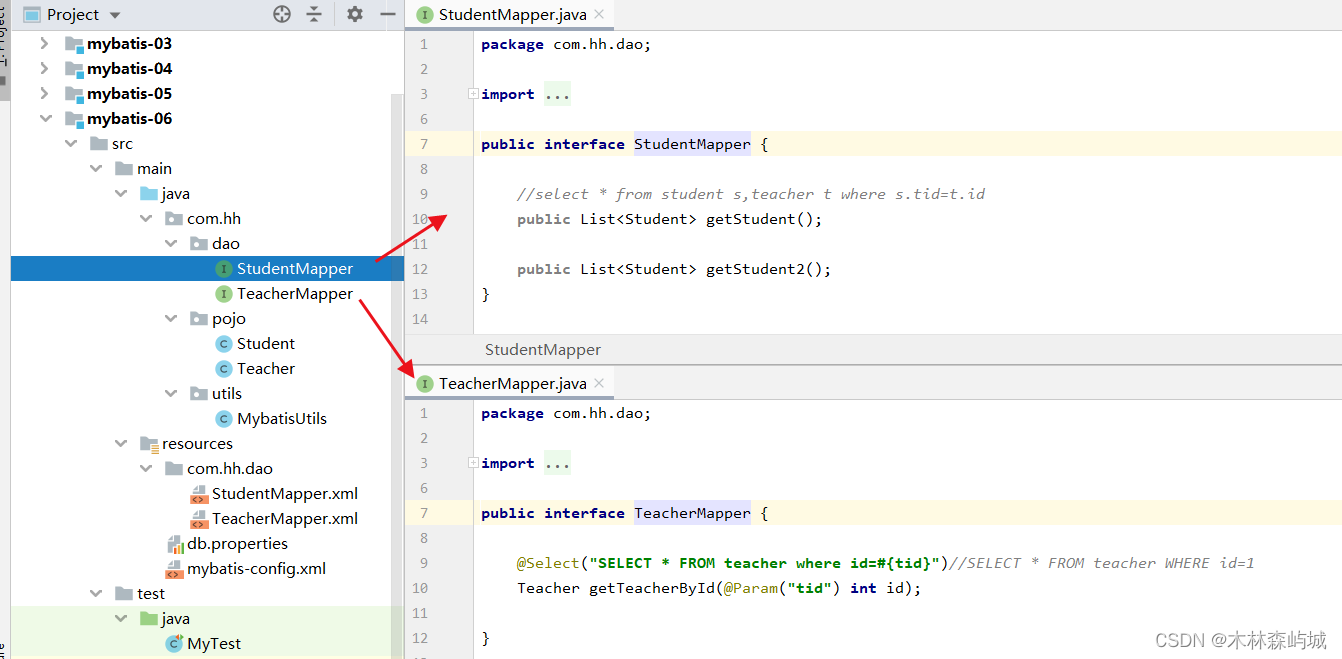
-
建立Mapper.XML文件
StudentMapper.xml:<?xml version="1.0" encoding="UTF-8" ?> <!DOCTYPE mapper PUBLIC "-//mybatis.org//DTD Config 3.0//EN" "http://mybatis.org/dtd/mybatis-3-mapper.dtd"> <mapper namespace="com.hh.dao.StudentMapper"> <!--方法一:按照查询嵌套处理--> <!-- 需要实现的效果: select s.id,s.name,t.name from student s,teacher t where s.tid=t.id 思路: 1.查询所有学生的信息 2.根据查询出来的学生的tid,寻找对应的老师 (子查询) 结果集映射 column数据库中的字段,property 实体类中的属性 --> <resultMap id="StudentTeacher" type="Student"> <result property="id" column="id"/> <result property="name" column="name"/> <!--复杂的属性需要单独处理 对象:association 集合:collection --> <association property="teacher" column="tid" javaType="Teacher" select="getTeacher"/> </resultMap> <select id="getStudent" resultMap="StudentTeacher"> /* resultType="Student"*/ select * from student </select> <select id="getTeacher" resultType="Teacher"> select * from teacher where id =#{id} </select> <!--方法二:按照结果嵌套处理( 联表查询 ) --> <select id="getStudent2" resultMap="StudentTeacher2"> select s.id sid,s.name sname,t.name tname from student s,teacher t where s.tid = t.id; </select> <resultMap id="StudentTeacher2" type="Student"> <result property="id" column="sid"/> <result property="name" column="sname"/> <association property="teacher" javaType="Teacher"> <result property="name" column="tname"/> </association> </resultMap> </mapper>TeacherMapper.xml:
<?xml version="1.0" encoding="UTF-8" ?> <!DOCTYPE mapper PUBLIC "-//mybatis.org//DTD Config 3.0//EN" "http://mybatis.org/dtd/mybatis-3-mapper.dtd"> <mapper namespace="com.hh.dao.TeacherMapper"></mapper> -
在核心配置文件中绑定注册我们的Mapper接口或者文件!【方式很多,随心选】
<?xml version="1.0" encoding="UTF-8" ?> <!DOCTYPE configuration PUBLIC "-//mybatis.org//DTD Config 3.0//EN" "http://mybatis.org/dtd/mybatis-3-config.dtd"> <!--configuration核心配置文件--> <configuration> <!--引入外部配置文件--> <properties resource="db.properties"/> <settings> <!--STDOUT_LOGGING:标准日志格式 --> <setting name="logImpl" value="STDOUT_LOGGING"/> </settings> <!-- 可以给实体类起别名 --> <typeAliases> <typeAlias type="com.hh.pojo.Teacher" alias="Teacher"/> <typeAlias type="com.hh.pojo.Student" alias="Student"/> </typeAliases> <environments default="development"> <environment id="development"> <!--事务管理器:transactionManager --> <transactionManager type="JDBC"/> <!-- 数据源:dataSource --> <dataSource type="POOLED"> <property name="driver" value="${driver}"/> <property name="url" value="${url}"/> <property name="username" value="${username}"/> <property name="password" value="${password}"/> </dataSource> </environment> </environments> <mappers> <!--<mapper resource="com/hh/dao/TeacherMapper.xml"/>--> <mapper class="com.hh.dao.TeacherMapper"/> <mapper class="com.hh.dao.StudentMapper"/> </mappers> </configuration> -
测试查询是否能够成功!
import com.hh.dao.StudentMapper; import com.hh.dao.TeacherMapper; import com.hh.pojo.Student; import com.hh.pojo.Teacher; import com.hh.utils.MybatisUtils; import org.apache.ibatis.session.SqlSession; import org.junit.Test; import java.util.List; public class MyTest { /* 运行main 出错就需要 pom.xml bulid 插件exec-maven-plugin */ public static void main(String[] args) { SqlSession sqlSession = MybatisUtils.getSqlSession(); TeacherMapper mapper = sqlSession.getMapper(TeacherMapper.class); Teacher teacher = mapper.getTeacherById(1); System.out.println("-------------"+teacher); sqlSession.close(); } @Test public void testStudent(){ SqlSession sqlSession = MybatisUtils.getSqlSession(); StudentMapper mapper = sqlSession.getMapper(StudentMapper.class); List<Student> studentList = mapper.getStudent(); for (Student student : studentList) { System.out.println("学生----------"+student); } sqlSession.close(); } @Test public void testStudent2(){ SqlSession sqlSession = MybatisUtils.getSqlSession(); StudentMapper mapper = sqlSession.getMapper(StudentMapper.class); List<Student> studentList = mapper.getStudent2(); for (Student student : studentList) { System.out.println("学生----------"+student); } sqlSession.close(); } }
按照查询嵌套处理
<!--
思路:
1. 查询所有的学生信息
2. 根据查询出来的学生的tid,寻找对应的老师! 子查询
-->
<select id="getStudent" resultMap="StudentTeacher">
select * from student
</select>
<resultMap id="StudentTeacher" type="Student">
<result property="id" column="id"/>
<result property="name" column="name"/>
<!--复杂的属性,我们需要单独处理 对象: association 集合: collection -->
<association property="teacher" column="tid" javaType="Teacher" select="getTeacher"/>
</resultMap>
<select id="getTeacher" resultType="Teacher">
select * from teacher where id = #{id}
</select>
按照结果嵌套处理
<!--按照结果嵌套处理-->
<select id="getStudent2" resultMap="StudentTeacher2">
select s.id sid,s.name sname,t.name tname
from student s,teacher t
where s.tid = t.id;
</select>
<resultMap id="StudentTeacher2" type="Student">
<result property="id" column="sid"/>
<result property="name" column="sname"/>
<association property="teacher" javaType="Teacher">
<result property="name" column="tname"/>
</association>
</resultMap>
回顾Mysql 多对一查询方式:子查询、联表查询
一对多
比如:一个老师拥有多个学生!
对于老师而言,就是一对多的关系!
环境搭建
案例 mybatis07:(MybatisUtils上面有)
-
导入lombok
-
新建实体类 Teacher,Student
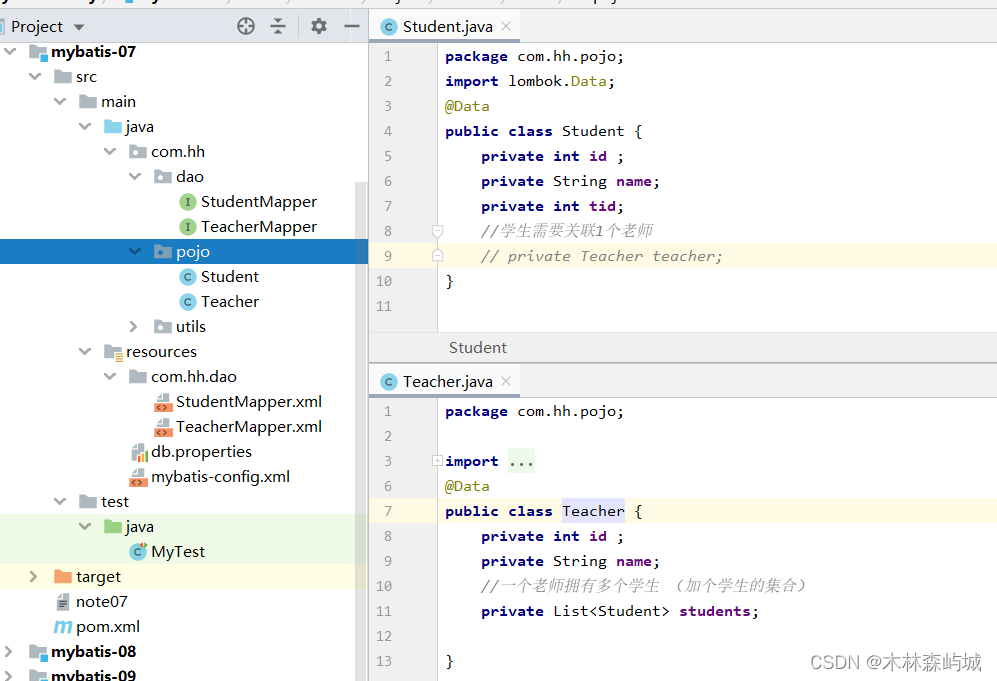
-
建立Mapper接口
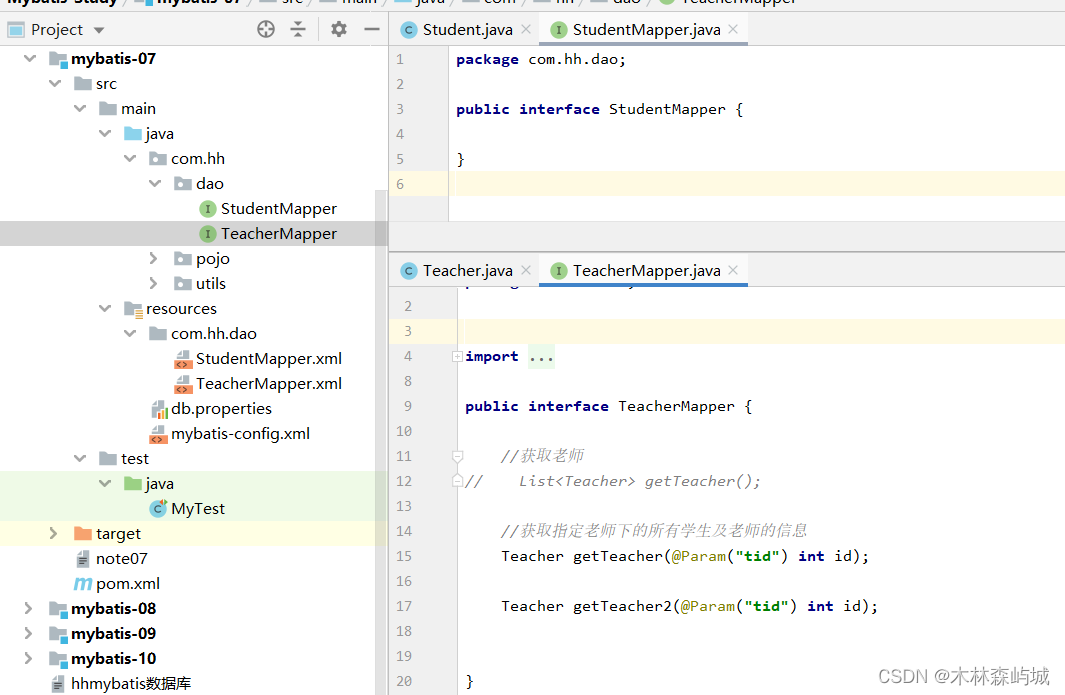
-
建立Mapper.XML文件
<?xml version="1.0" encoding="UTF-8" ?> <!DOCTYPE mapper PUBLIC "-//mybatis.org//DTD Config 3.0//EN" "http://mybatis.org/dtd/mybatis-3-mapper.dtd"> <mapper namespace="com.hh.dao.StudentMapper"> </mapper><?xml version="1.0" encoding="UTF-8" ?> <!DOCTYPE mapper PUBLIC "-//mybatis.org//DTD Config 3.0//EN" "http://mybatis.org/dtd/mybatis-3-mapper.dtd"> <mapper namespace="com.hh.dao.TeacherMapper"> <!--<select id="getTeacher" resultType="Teacher"> select * from hhmybatis.teacher </select>--> <!--===========按结果嵌套查询(推荐使用)==============================--> <select id="getTeacher" resultMap="TeacherStudent"> select s.id sid, s.name sname, t.name tname,t.id tid from student s,teacher t where s.tid = t.id and t.id = #{tid} </select> <resultMap id="TeacherStudent" type="Teacher"> <result property="id" column="tid"/> <result property="name" column="tname"/> <!-- 复杂的属性,我们需要单独处理 对象: association 集合: collection javaType="" 指定属性的类型! 集合中的泛型信息,我们使用ofType获取 --> <collection property="students" ofType="Student"> <result property="id" column="sid"/> <result property="name" column="sname"/> <result property="tid" column="tid"/> </collection> </resultMap> <!--================按照查询嵌套处理===============================--> <select id="getTeacher2" resultMap="TeacherStudent2"> select * from hhmybatis.teacher where id = #{tid} </select> <resultMap id="TeacherStudent2" type="Teacher"> <!-- property实体类字段 column:数据库字段 --> <!--<result property="id" column="id"/> <result property="name" column="name"/>--> <collection property="students" javaType="ArrayList" ofType="Student" select="getStudentByTeacherId" column="id"/> </resultMap> <select id="getStudentByTeacherId" resultType="Student"> select * from hhmybatis.student where tid = #{tid} </select> </mapper> -
在核心配置文件中绑定注册我们的Mapper接口或者文件!【方式很多,随心选】
<?xml version="1.0" encoding="UTF-8" ?> <!DOCTYPE configuration PUBLIC "-//mybatis.org//DTD Config 3.0//EN" "http://mybatis.org/dtd/mybatis-3-config.dtd"> <!--configuration核心配置文件--> <configuration> <!--引入外部配置文件--> <properties resource="db.properties"/> <settings> <!--STDOUT_LOGGING:标准日志格式 --> <setting name="logImpl" value="STDOUT_LOGGING"/> </settings> <!-- 可以给实体类起别名 --> <typeAliases> <typeAlias type="com.hh.pojo.Teacher" alias="Teacher"/> <typeAlias type="com.hh.pojo.Student" alias="Student"/> </typeAliases> <environments default="development"> <environment id="development"> <!--事务管理器:transactionManager --> <transactionManager type="JDBC"/> <!-- 数据源:dataSource --> <dataSource type="POOLED"> <property name="driver" value="${driver}"/> <property name="url" value="${url}"/> <property name="username" value="${username}"/> <property name="password" value="${password}"/> </dataSource> </environment> </environments> <mappers> <mapper resource="com.hh/dao/StudentMapper.xml"/> <mapper resource="com.hh/dao/TeacherMapper.xml"/> </mappers> </configuration> -
测试查询是否能够成功!
import com.hh.dao.TeacherMapper; import com.hh.pojo.Teacher; import com.hh.utils.MybatisUtils; import org.apache.ibatis.session.SqlSession; import org.junit.Test; import java.util.List; public class MyTest { @Test public void test(){ SqlSession sqlSession = MybatisUtils.getSqlSession(); TeacherMapper mapper = sqlSession.getMapper(TeacherMapper.class); Teacher teacher = mapper.getTeacher(1); System.out.println(teacher); // for (Teacher teacher : sqlSession.getMapper(TeacherMapper.class).getTeacher()) { // System.out.println(teacher); // } sqlSession.close(); } @Test public void test2(){ SqlSession sqlSession = MybatisUtils.getSqlSession(); TeacherMapper mapper = sqlSession.getMapper(TeacherMapper.class); Teacher teacher = mapper.getTeacher2(1); System.out.println(teacher); sqlSession.close(); } }
按照结果嵌套处理
<!--按结果嵌套查询-->
<select id="getTeacher" resultMap="TeacherStudent">
select s.id sid, s.name sname, t.name tname,t.id tid
from student s,teacher t
where s.tid = t.id and t.id = #{tid}
</select>
<resultMap id="TeacherStudent" type="Teacher">
<result property="id" column="tid"/>
<result property="name" column="tname"/>
<!--复杂的属性,我们需要单独处理 对象: association 集合: collection
javaType="" 指定属性的类型!
集合中的泛型信息,我们使用ofType获取
-->
<collection property="students" ofType="Student">
<result property="id" column="sid"/>
<result property="name" column="sname"/>
<result property="tid" column="tid"/>
</collection>
</resultMap>
按照查询嵌套处理
<select id="getTeacher2" resultMap="TeacherStudent2">
select * from mybatis.teacher where id = #{tid}
</select>
<resultMap id="TeacherStudent2" type="Teacher">
<collection property="students" javaType="ArrayList" ofType="Student" select="getStudentByTeacherId" column="id"/>
</resultMap>
<select id="getStudentByTeacherId" resultType="Student">
select * from mybatis.student where tid = #{tid}
</select>
小结:
- 关联 - association 【多对一】
- 集合 - collection 【一对多】
- javaType & ofType
(1)JavaType 用来指定实体类中属性的类型
(2)ofType 用来指定映射到List或者集合中的 pojo类型,泛型中的约束类型!
注意点:
- 保证SQL的可读性,尽量保证通俗易懂
- 注意一对多和多对一中,属性名和字段的问题!
- 如果问题不好排查错误,可以使用日志 , 建议使用 Log4j
慢SQL 1s 1000s
面试高频:Mysql引擎、InnoDB底层原理、索引、索引优化!
动态SQL
什么是动态SQL:动态SQL就是指根据不同的条件生成不同的SQL语句
利用动态 SQL 这一特性可以彻底摆脱这种痛苦。
动态 SQL 元素和 JSTL 或基于类似 XML 的文本处理器相似。在 MyBatis 之前的版本中,有很多元素需要花时间了解。
MyBatis 3 大大精简了元素种类,现在只需学习原来一半的元素便可。
MyBatis 采用功能强大的基于 OGNL 的表达式来淘汰其它大部分元素。
if
choose (when, otherwise)
trim (where, set)
foreach
准备表:
CREATE TABLE `blog` (
`id` varchar(50) NOT NULL COMMENT '博客id',
`title` varchar(100) NOT NULL COMMENT '博客标题',
`author` varchar(30) NOT NULL COMMENT '博客作者',
`create_time` datetime NOT NULL COMMENT '创建时间',
`views` int(30) NOT NULL COMMENT '浏览量'
) ENGINE=InnoDB DEFAULT CHARSET=utf8
环境搭建
案例 mybatis08:(MybatisUtils、db.properties前面有)
- 导包
- 编写配置文件
- 编写实体类
package com.hh.pojo;
import lombok.Data;
import java.util.Date;
//import java.sql.Date; //注意:这里导包不要用 java.sql的包,不然获取不到时间
@Data
public class Blog {
private String id;//varchar(50)
private String title;
private String author;
/*
数据库存储字段 create_time
数据库字段不一致问题在 核心配置文件中mybatis-config.xml
用setting配置驼峰命名规则
*/
private Date createTime;
private int views;
}
- 编写实体类对应Mapper接口 和 Mapper.XML文件
接口BlogMapper :
package com.hh.dao;
import com.hh.pojo.Blog;
import java.util.List;
import java.util.Map;
public interface BlogMapper {
//插入数据
int addBlog (Blog blog);
//查询博客
List<Blog> queryBlogIF(Map map);//IF
List<Blog> queryBlogChoose(Map map); //choose (when, otherwise)
//更新博客
int updateBlog(Map map);
//Foreach循环迭代 (查询1-2-3号记录的博客) queryBlogForeach
List<Blog> queryBlogForeach(Map map);
}
BlogMapper.xml:
<?xml version="1.0" encoding="UTF-8" ?>
<!DOCTYPE mapper
PUBLIC "-//mybatis.org//DTD Config 3.0//EN"
"http://mybatis.org/dtd/mybatis-3-mapper.dtd">
<mapper namespace="com.hh.dao.BlogMapper">
<insert id="addBlog" parameterType="blog">
insert into hhmybatis.blog(id,title,author,create_time,views)
values (#{id},#{title},#{author},#{createTime},#{views});
</insert>
<!--
SQL片段: 有的时候,我们可能会将一些功能的部分抽取出来,方便复用!
注意事项: 最好基于单表来定义SQL片段! 不要存在where标签
-->
<!--这里把IF语句抽取出来复用-->
<sql id="if-title-author">
<if test="title != null">
and title = #{title}
</if>
<if test="author != null">
and author = #{author}
</if>
</sql>
<!--
select * from hhmybatis.blog where 1=1 and title = 'Mybatis《动态SQL环境搭建》'
select * from hhmybatis.blog where 1=1
-->
<select id="queryBlogIF" parameterType="map" resultType="blog">
select * from hhmybatis.blog
<where>
<include refid="if-title-author"></include>
</where>
</select>
<!-- //choose (when, otherwise)-->
<select id="queryBlogChoose" parameterType="map" resultType="blog">
select * from hhmybatis.blog
<where>
<choose>
<when test="title != null">
title = #{title}
</when>
<when test="author != null">
and author = #{author}
</when>
<otherwise>
and views = #{views}
</otherwise>
</choose>
</where>
</select>
<!--更新-->
<update id="updateBlog" parameterType="map">
update hhmybatis.blog
<set>
<if test="title != null">
title = #{title},
</if>
<if test="author != null">
author = #{author}
</if>
</set>
where id = #{id}
</update>
<!--
Foreach循环迭代
select * from hhmybatis.blog where 1=1 and (id=1 or id = 2 or id=3)
我们现在传递一个万能的map , 这map中可以存在一个集合!
-->
<select id="queryBlogForeach" parameterType="map" resultType="blog">
select * from hhmybatis.blog
<where>
<foreach collection="ids" item="id" open="and (" close=")" separator="or">
id = #{id}
</foreach>
</where>
</select>
</mapper>
工具类IdUtils:
package com.hh.utils;
import org.junit.Test;
import java.util.UUID;
//@SuppressWarnings("all")//抑制警告
public class IdUtils {
public static String getId(){
//return UUID.randomUUID().toString();5001281a-7bd5-4684-967b-df95f3ff5d28
return UUID.randomUUID().toString().replaceAll("-","");
//81b428a2e61e4aa7adf33a64c298e9b7
}
@Test
public void test(){
// System.out.println(IdUtils.getId());
// System.out.println(IdUtils.getId());
// System.out.println(IdUtils.getId());
// 96c88039fa6d47458049ab9481c2f0bd
// 5540d1fec42a449792a199d4ce0d34b3
// ea20b7f0e060464da2807590c3d5cb66
}
}
- 核心配置文件
mybatis-config.xml:
<?xml version="1.0" encoding="UTF-8" ?>
<!DOCTYPE configuration
PUBLIC "-//mybatis.org//DTD Config 3.0//EN"
"http://mybatis.org/dtd/mybatis-3-config.dtd">
<!--configuration核心配置文件-->
<configuration>
<!--引入外部配置文件-->
<properties resource="db.properties"/>
<!--STDOUT_LOGGING:标准日志格式 -->
<settings>
<setting name="logImpl" value="STDOUT_LOGGING"/>
<!--是否开启自动驼峰命名规则 camel case 映射 -->
<setting name="mapUnderscoreToCamelCase" value="true"/>
</settings>
<!-- 可以给实体类起别名 -->
<typeAliases>
<!--直接扫描整个实体类包,实体类十分多的时候使用,别名DIY就是在实体类上添加 @Alias("user") -->
<package name="com.hh.pojo"/>
</typeAliases>
<environments default="development">
<environment id="development">
<transactionManager type="JDBC"/> <!--事务管理器:transactionManager -->
<dataSource type="POOLED"> <!-- 数据源:dataSource -->
<property name="driver" value="${driver}"/>
<property name="url" value="${url}"/>
<property name="username" value="${username}"/>
<property name="password" value="${password}"/>
</dataSource>
</environment>
</environments>
<mappers>
<mapper class="com.hh.dao.BlogMapper"/>
</mappers>
</configuration>
- 测试
import com.hh.dao.BlogMapper;
import com.hh.pojo.Blog;
import com.hh.utils.IdUtils;
import com.hh.utils.MybatisUtils;
import org.apache.ibatis.session.SqlSession;
import org.junit.Test;
import java.util.ArrayList;
import java.util.Date;
import java.util.HashMap;
import java.util.List;
public class MyTest {
@Test
public void addInitBlog(){
SqlSession sqlSession = MybatisUtils.getSqlSession();
BlogMapper mapper = sqlSession.getMapper(BlogMapper.class);
//new 一个新对象存放新增信息
Blog blog = new Blog();
blog.setId(IdUtils.getId());
blog.setTitle("Mybatis《动态SQL环境搭建》");
blog.setAuthor("狂神说");
blog.setCreateTime(new Date());
blog.setViews(9999);
mapper.addBlog(blog);
blog.setId(IdUtils.getId());
blog.setTitle("Java 如此简单");
mapper.addBlog(blog);
blog.setId(IdUtils.getId());
blog.setTitle("Spring 如此简单");
mapper.addBlog(blog);
blog.setId(IdUtils.getId());
blog.setTitle("微服务如此简单");
mapper.addBlog(blog);
sqlSession.close();
}
@Test
public void queryBlogIF(){
SqlSession sqlSession = MybatisUtils.getSqlSession();
BlogMapper mapper = sqlSession.getMapper(BlogMapper.class);
HashMap map = new HashMap();
map.put("title","Mybatis《动态SQL环境搭建》");
// map.put("author","狂神说");
List<Blog> blogs = mapper.queryBlogIF(map);
for (Blog blog : blogs) {
System.out.println(blog);
}
sqlSession.close();
}
@Test
public void queryBlogChoose(){
SqlSession sqlSession = MybatisUtils.getSqlSession();
BlogMapper mapper = sqlSession.getMapper(BlogMapper.class);
HashMap map = new HashMap();
map.put("title","微服务如此简单");
map.put("author","狂神说");
map.put("views",9999);//int 类型不需要加""
List<Blog> blogs = mapper.queryBlogChoose(map);
for (Blog blog : blogs) {
System.out.println(blog);
}
sqlSession.close();
}
@Test
public void updateBlog(){
SqlSession sqlSession = MybatisUtils.getSqlSession();
BlogMapper mapper = sqlSession.getMapper(BlogMapper.class);
HashMap map = new HashMap();
map.put("title","微服务如此简单2");
map.put("author","狂神说3");
map.put("id","37e738d841ab47be9d9e7cdd961b9dcc");//id 为 varchar 类型所以需要用到""
mapper.updateBlog(map);
sqlSession.close();
}
@Test
public void queryBlogForeach(){
SqlSession sqlSession = MybatisUtils.getSqlSession();
BlogMapper mapper = sqlSession.getMapper(BlogMapper.class);
HashMap map = new HashMap();
ArrayList<Integer> ids = new ArrayList<>();
ids.add(1);// Preparing: select * from hhmybatis.blog WHERE ( id = ? )
ids.add(2);//Preparing: select * from hhmybatis.blog WHERE ( id = ? or id = ? )
map.put("ids",ids);// Preparing: select * from hhmybatis.blog
List<Blog> blogs = mapper.queryBlogForeach(map);
for (Blog blog : blogs) {
System.out.println(blog);
}
sqlSession.close();
}
}
IF
<select id="queryBlogIF" parameterType="map" resultType="blog">
select * from mybatis.blog where 1=1
<if test="title != null">
and title = #{title}
</if>
<if test="author != null">
and author = #{author}
</if>
</select>
choose (when, otherwise)
<select id="queryBlogChoose" parameterType="map" resultType="blog">
select * from mybatis.blog
<where>
<choose>
<when test="title != null">
title = #{title}
</when>
<when test="author != null">
and author = #{author}
</when>
<otherwise>
and views = #{views}
</otherwise>
</choose>
</where>
</select>
trim (where,set)
select * from mybatis.blog
<where>
<if test="title != null">
title = #{title}
</if>
<if test="author != null">
and author = #{author}
</if>
</where>
<update id="updateBlog" parameterType="map">
update mybatis.blog
<set>
<if test="title != null">
title = #{title},
</if>
<if test="author != null">
author = #{author}
</if>
</set>
where id = #{id}
</update>
所谓的动态SQL,本质还是SQL语句 , 只是我们可以在SQL层面,去执行一个逻辑代码
SQL片段
有的时候,我们可能会将一些功能的部分抽取出来,方便复用!
- 使用SQL标签抽取公共的部分
<sql id="if-title-author">
<if test="title != null">
title = #{title}
</if>
<if test="author != null">
and author = #{author}
</if>
</sql>
- 在需要使用的地方使用Include标签引用即可
<select id="queryBlogIF" parameterType="map" resultType="blog">
select * from mybatis.blog
<where>
<include refid="if-title-author"></include>
</where>
</select>
注意事项:
- 最好基于单表来定义SQL片段!
- 不要存在where标签
Foreach
select * from user where 1=1 and
<foreach item="id" collection="ids"
open="(" separator="or" close=")">
#{id}
</foreach>
(id=1 or id=2 or id=3)
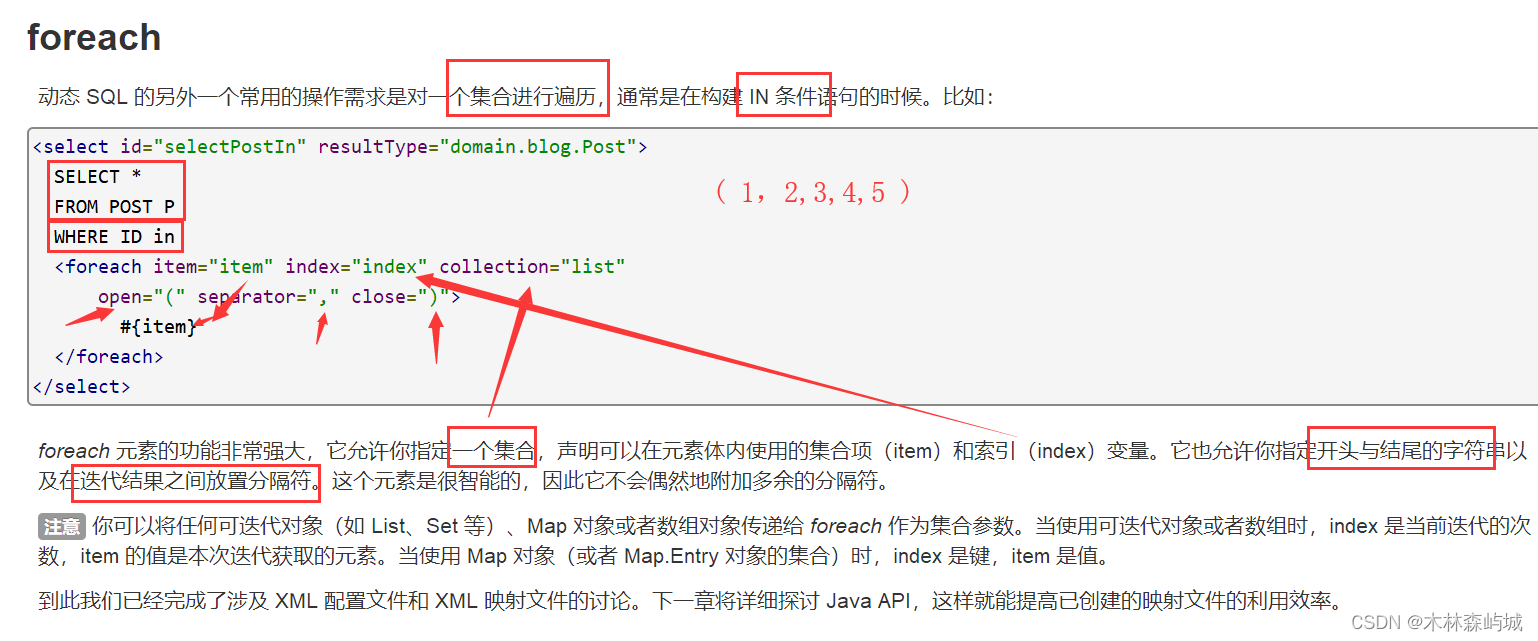
<!--
select * from mybatis.blog where 1=1 and (id=1 or id = 2 or id=3)
我们现在传递一个万能的map , 这map中可以存在一个集合!
-->
<select id="queryBlogForeach" parameterType="map" resultType="blog">
select * from mybatis.blog
<where>
<foreach collection="ids" item="id" open="and (" close=")" separator="or">
id = #{id}
</foreach>
</where>
</select>
动态SQL就是在拼接SQL语句,我们只要保证SQL的正确性,按照SQL的格式,去排列组合就可以了
建议:现在Mysql中写出完整的SQL,再对应的去修改成为我们的动态SQL实现通用即可!
Mybatis缓存
查询 : 连接数据库 ,耗资源!
一次查询的结果,给他暂存在一个可以直接取到的地方!--> 内存 : 缓存
我们再次查询相同数据的时候,直接走缓存,就不用走数据库了
什么是缓存 [ Cache ]?
存在内存中的临时数据。
将用户经常查询的数据放在缓存(内存)中,用户去查询数据就不用从磁盘上(关系型数据库数据文件)查询,从缓存中查询,从而提高查询效率,解决了高并发系统的性能问题。
为什么使用缓存?
减少和数据库的交互次数,减少系统开销,提高系统效率。
什么样的数据能使用缓存?
经常查询并且不经常改变的数据。【可以使用缓存】
MyBatis包含一个非常强大的查询缓存特性,它可以非常方便地定制和配置缓存。缓存可以极大的提升查询效率。
一级缓存
一级缓存也叫本地缓存: SqlSession
与数据库同一次会话期间查询到的数据会放在本地缓存中。
以后如果需要获取相同的数据,直接从缓存中拿,没必须再去查询数据库;
Mybatis对缓存提供支持,但是在没有配置的默认情况下,它只开启一级缓存,一级缓存只是相对于同一个SqlSession而言。所以在参数和SQL完全一样的情况下,我们使用同一个SqlSession对象调用一个Mapper方法,往往只执行一次SQL,因为使用SelSession第一次查询后,MyBatis会将其放在缓存中,以后再查询的时候,如果没有声明需要刷新,并且缓存没有超时的情况下,SqlSession都会取出当前缓存的数据,而不会再次发送SQL到数据库。


一次会话中有效
为什么要使用一级缓存,不用多说也知道个大概。但是还有几个问题我们要注意一下。
1、一级缓存的生命周期有多长?
a、 MyBatis在开启一个数据库会话时,会 创建一个新的SqlSession对象,SqlSession对象中会有一个新的Executor对象。Executor对象中持有一个新的PerpetualCache对象;当会话结束时,SqlSession对象及其内部的Executor对象还有PerpetualCache对象也一并释放掉。
b、如果SqlSession调用了close()方法,会释放掉一级缓存PerpetualCache对象,一级缓存将不可用。
c、如果SqlSession调用了clearCache(),会清空PerpetualCache对象中的数据,但是该对象仍可使用。
d、SqlSession中执行了任何一个update操作(update()、delete()、insert()) ,都会清空PerpetualCache对象的数据,但是该对象可以继续使用
2、怎么判断某两次查询是完全相同的查询?
mybatis认为,对于两次查询,如果以下条件都完全一样,那么就认为它们是完全相同的两次查询。
2.1 传入的statementId
2.2 查询时要求的结果集中的结果范围
2.3. 这次查询所产生的最终要传递给JDBC java.sql.Preparedstatement的Sql语句字符串(boundSql.getSql() )
2.4 传递给java.sql.Statement要设置的参数值
缓存失效的情况:
1.查询不同的东西
2.执行CRUD操作(改变原来的数据所以必定会刷新缓存)
3.查询不同的Mapper.xml
4.手动清理缓存 sqlSession.clearCache();
小结:一级缓存默认是开启的,只在一次SqlSession中有效,也就是拿到连接到关闭连接这个区间段!
一级缓存就是一个Map。
二级缓存:
二级缓存也叫全局缓存,一级缓存作用域太低了,所以诞生了二级缓存
基于namespace级别的缓存,一个名称空间,对应一个二级缓存;
工作机制:
- 一个会话查询一条数据,这个数据就会被放在当前会话的一级缓存中;
- 如果当前会话关闭了,这个会话对应的一级缓存就没了;但是我们想要的是,会话关闭了,一级缓存中的数据被保存到二级缓存中;
- 新的会话查询信息,就可以从二级缓存中获取内容;
- 不同的mapper查出的数据会放在自己对应的缓存(map)中;
MyBatis的二级缓存是Application级别的缓存,它可以提高对数据库查询的效率,以提高应用的性能。
MyBatis的缓存机制整体设计以及二级缓存的工作模式

SqlSessionFactory层面上的二级缓存默认是不开启的,二级缓存的开席需要进行配置,实现二级缓存的时候,MyBatis要求返回的POJO必须是可序列化的。 也就是要求实现Serializable接口,配置方法很简单,只需要在映射XML文件配置就可以开启缓存了,如果我们配置了二级缓存就意味着:
映射语句文件中的所有select语句将会被缓存。
映射语句文件中的所欲insert、update和delete语句会刷新缓存。
缓存会使用默认的Least Recently Used(LRU,最近最少使用的)算法来收回。
根据时间表,比如No Flush Interval,(CNFI没有刷新间隔),缓存不会以任何时间顺序来刷新。
缓存会存储列表集合或对象(无论查询方法返回什么)的1024个引用
缓存会被视为是read/write(可读/可写)的缓存,意味着对象检索不是共享的,而且可以安全的被调用者修改,不干扰其他调用者或线程所做的潜在修改。
小结:
只要开启了二级缓存,在同一个Mapper下就有效
所有的数据都会先放在一级缓存中;
只有当会话提交,或者关闭的时候,才会提交到二级缓冲中!

案例 mybatis09
pom.xml:
<!--自定义缓存-ehcache https://mvnrepository.com/artifact/org.mybatis.caches/mybatis-ehcache -->
<dependency>
<groupId>org.mybatis.caches</groupId>
<artifactId>mybatis-ehcache</artifactId>
<version>1.2.1</version>
</dependency>
db.properties、MybatisUtils 前面有
实体类:
package com.hh.pojo;
import lombok.AllArgsConstructor;
import lombok.Data;
import lombok.NoArgsConstructor;
import java.io.Serializable;
@Data //getter setter
@NoArgsConstructor // 无参构造
@AllArgsConstructor //有参构造
public class User implements Serializable {
private int id;
private String name;
private String pwd;
}
有时候粗心大意就会忘记序列化实体类
会报:Caused by: java.io.NotSerializableException: com.hh.pojo.User
解决:User implements Serializable
其实不进行序列化也可以,就是需要在ehcache.xml添加下面代码:
<cache eviction="FIFO"
flushInterval="60000"
size="512"
readOnly="true"/>
ehcache.xml:
<?xml version="1.0" encoding="UTF-8"?>
<ehcache xmlns:xsi="http://www.w3.org/2001/XMLSchema-instance"
xsi:noNamespaceSchemaLocation="http://ehcche.org/ehcache.xsd"
updateCheck="false">
<!--
diskStore:为缓存路径,ehcache分为内存和磁盘两级,此属性定义磁盘的缓存位置。参数解释如下:
user.home – 用户主目录
user.dir – 用户当前工作目录
java.io.tmpdir – 默认临时文件路径
-->
<diskStore path="./tmpdir/Tmp_EhCache"/>
<defaultCache
eternal="false"
maxElementsInMemory="10000"
overflowToDisk="false"
diskPersistent="false"
timeToIdleSeconds="1800"
timeToLiveSeconds="259200"
memoryStoreEvictionPolicy="LRU"/>
<cache
name="cloud_user"
eternal="false"
maxElementsInMemory="5000"
overflowToDisk="false"
diskPersistent="false"
timeToIdleSeconds="1800"
timeToLiveSeconds="1800"
memoryStoreEvictionPolicy="LRU"/>
<!--
defaultCache:默认缓存策略,当ehcache找不到定义的缓存时,则使用这个缓存策略。只能定义一个。
-->
<!--
name:缓存名称。
maxElementsInMemory:缓存最大数目
maxElementsOnDisk:硬盘最大缓存个数。
eternal:对象是否永久有效,一但设置了,timeout将不起作用。
overflowToDisk:是否保存到磁盘,当系统宕机时
timeToIdleSeconds:设置对象在失效前的允许闲置时间(单位:秒)。仅当eternal=false对象不是永久有效时使用,可选属性,默认值是0,也就是可闲置时间无穷大。
timeToLiveSeconds:设置对象在失效前允许存活时间(单位:秒)。最大时间介于创建时间和失效时间之间。仅当eternal=false对象不是永久有效时使用,默认是0.,也就是对象存活时间无穷大。
diskPersistent:是否缓存虚拟机重启期数据 Whether the disk store persists between restarts of the Virtual Machine. The default value is false.
diskSpoolBufferSizeMB:这个参数设置DiskStore(磁盘缓存)的缓存区大小。默认是30MB。每个Cache都应该有自己的一个缓冲区。
diskExpiryThreadIntervalSeconds:磁盘失效线程运行时间间隔,默认是120秒。
memoryStoreEvictionPolicy:当达到maxElementsInMemory限制时,Ehcache将会根据指定的策略去清理内存。默认策略是LRU(最近最少使用)。你可以设置为FIFO(先进先出)或是LFU(较少使用)。
clearOnFlush:内存数量最大时是否清除。
memoryStoreEvictionPolicy:可选策略有:LRU(最近最少使用,默认策略)、FIFO(先进先出)、LFU(最少访问次数)。
FIFO,first in first out,这个是大家最熟的,先进先出。
LFU, Less Frequently Used,就是上面例子中使用的策略,直白一点就是讲一直以来最少被使用的。如上面所讲,缓存的元素有一个hit属性,hit值最小的将会被清出缓存。
LRU,Least Recently Used,最近最少使用的,缓存的元素有一个时间戳,当缓存容量满了,而又需要腾出地方来缓存新的元素的时候,那么现有缓存元素中时间戳离当前时间最远的元素将被清出缓存。
-->
</ehcache>
解决ehcache.xml里面的 http://ehcche.org/ehcache.xsd爆红问题:
file --> settings- -> languages & frameworks -->Schemas and DTDs,点击+,将复制的内容粘贴进输入框,然后点击OK,再点击apply就行了。
核心配置文件mybatis-config.xml:
<?xml version="1.0" encoding="UTF-8" ?>
<!DOCTYPE configuration
PUBLIC "-//mybatis.org//DTD Config 3.0//EN"
"http://mybatis.org/dtd/mybatis-3-config.dtd">
<!--configuration核心配置文件-->
<configuration>
<!--引入外部配置文件-->
<properties resource="db.properties"/>
<settings>
<!--STDOUT_LOGGING:标准日志格式 -->
<setting name="logImpl" value="STDOUT_LOGGING"/>
<!--是否开启自动驼峰命名规则 camel case 映射 -->
<!--<setting name="mapUnderscoreToCamelCase" value="true"/>-->
<!-- 二级缓存第一步: 显示的开启全局缓存-->
<setting name="cacheEnabled" value="true"/>
</settings>
<!-- 可以给实体类起别名 -->
<typeAliases>
<package name="com.hh.pojo"/>
</typeAliases>
<environments default="development">
<environment id="development">
<transactionManager type="JDBC"/> <!--事务管理器:transactionManager -->
<dataSource type="POOLED"> <!-- 数据源:dataSource -->
<property name="driver" value="${driver}"/>
<property name="url" value="${url}"/>
<property name="username" value="${username}"/>
<property name="password" value="${password}"/>
</dataSource>
</environment>
</environments>
<mappers>
<mapper class="com.hh.dao.UserMapper"/>
</mappers>
</configuration>
UserMapper接口:
package com.hh.dao;
import com.hh.pojo.User;
import org.apache.ibatis.annotations.Param;
public interface UserMapper {
//根据id查询用户
User queryUserById(@Param("id") int id);
//修改数据库
int updateUser(User user);
}
UserMapper.xml:
<?xml version="1.0" encoding="UTF-8" ?>
<!DOCTYPE mapper
PUBLIC "-//mybatis.org//DTD Config 3.0//EN"
"http://mybatis.org/dtd/mybatis-3-mapper.dtd">
<mapper namespace="com.hh.dao.UserMapper">
<!-- 二级缓存第二步: 在当前Mapper.xml中使用二级缓存 <cache/> -->
<cache type="org.mybatis.caches.ehcache.EhcacheCache"/><!--自定义缓存-->
<!-- parameterType="_int":参数省略 useCache="false":关闭缓存-->
<select id="queryUserById" resultType="user" useCache="true">
select * from user where id=#{id}
</select>
<update id="updateUser" parameterType="user">
update user set name=#{name}, pwd=#{pwd} where id=#{id}
</update>
</mapper>
测试:
import com.hh.dao.UserMapper;
import com.hh.pojo.User;
import com.hh.utils.MybatisUtils;
import org.apache.ibatis.session.SqlSession;
import org.junit.Test;
public class MyTest {
//二级缓存测试
@Test
public void test(){
SqlSession sqlSession = MybatisUtils.getSqlSession();
SqlSession sqlSession2 = MybatisUtils.getSqlSession();
UserMapper mapper = sqlSession.getMapper(UserMapper.class);
User user = mapper.queryUserById(1);
System.out.println("----------------"+user);
sqlSession.close();
UserMapper mapper2 = sqlSession2.getMapper(UserMapper.class);
User user2 = mapper2.queryUserById(1);
System.out.println("----------------"+user2);
sqlSession2.close();
// System.out.println(user==user2);//false 证明不是来自于同一个一级缓存,user2 是请求的二级缓存
}
//测试一级缓存作用域
@Test
public void queryUserById(){
SqlSession sqlSession = MybatisUtils.getSqlSession();
UserMapper mapper = sqlSession.getMapper(UserMapper.class);
User user = mapper.queryUserById(1);
System.out.println("第一次---------"+user);
User user2 = mapper.queryUserById(1);
System.out.println("第二次---------"+user2);
System.out.println(user==user2);
sqlSession.close();
}
//测试一级缓存失效的情况
@Test
public void updateUser(){
SqlSession sqlSession = MybatisUtils.getSqlSession();
UserMapper mapper = sqlSession.getMapper(UserMapper.class);
User user = mapper.queryUserById(1);
System.out.println("第一次---------"+user);
// mapper.updateUser(new User(2,"彭彭","852010"));
// sqlSession.clearCache();//手动清理缓存
User user2 = mapper.queryUserById(1);
System.out.println("第二次---------"+user2);
System.out.println(user==user2);
sqlSession.close();
}
}
Mybatis常遇到的异常(笔记)
mybatis-spring整合包【重点】
mybatis:使用3.5+的; mybatis-spring就必须使用 2.0+的 ; spring:5.0+ ; Java:8+
mybatis:使用3.4+的; mybatis-spring就必须使用 1.3+的 ; spring:3.2.2+ ; Java:6+

看到下面这个异常就需要注意:mysql的版本 版本8用 com.mysql.cj.jdbc.Driver 版本5 用 com.mysql.jdbc.Driver
Loading class `com.mysql.jdbc.Driver'. This is deprecated.The new driver class is `com.mysql.cj.jdbc.Driver'.
The driver is automatically registered via the SPI and manual loading of the driver class is generally unnecessary.
<!--mysql驱动-->
<dependency>
<groupId>mysql</groupId>
<artifactId>mysql-connector-java</artifactId>
<version>8.0.27</version>
</dependency>
<property name="driver" value="com.mysql.cj.jdbc.Driver"/>
<!--mysql驱动-->
<dependency>
<groupId>mysql</groupId>
<artifactId>mysql-connector-java</artifactId>
<version>5.1.47</version>
</dependency>
<property name="driver" value="com.mysql.jdbc.Driver"/>
异常 1、接口UserMapper 没有登记注册进MapperRegistry
org.apache.ibatis.binding.BindingException: Type interface com.hh.mapper.UserMapper is not known to the MapperRegistry.

解决(在核心配置文件mybatis-config.xml中添加上)
<mappers>
<mapper class="com.hh.mapper.UserMapper"/>
或者用
<mapper resource="com/hh/dao/UserMapper.xml"/>
</mappers>
异常2 : 找不到核心配置文件
java.io.IOException: Could not find resource mybatis-config.xml
解决:(在pom.xml中添加在build时要扫描的包以及文件的后缀)
<build>
<resources>
<resource>
<directory>src/main/java</directory>
<includes>
<include>**/*.properties</include>
<include>**/*.xml</include>
</includes>
<filtering>false</filtering>
</resource>
<resource>
<directory>src/main/resources</directory>
<includes>
<include>**/*.properties</include>
<include>**/*.xml</include>
</includes>
<filtering>false</filtering>
</resource>
</resources>
</build>
异常3:maven install时报执行目标org.apache.maven.plugins:maven-surefire-plugin:2.12.4:test失败
maven install时报错
Failed to execute goal org.apache.maven.plugins:maven-surefire-plugin:2.12.4:test
解决:
- 在项目路径下 cmd 进入命令行执行清除
mvn clean package -Dmaven.test.skip=true(例如:H:\mybatis\ Mybatis-Study) - 在
pom.xml文件添加
<plugin>
<groupId>org.apache.maven.plugins</groupId>
<artifactId>maven-surefire-plugin</artifactId>
<version>2.4.2</version>
<configuration>
<skipTests>true</skipTests>
</configuration>
</plugin>
异常4:SQL异常
Cause: com.mysql.jdbc.exceptions.jdbc4.MySQLSyntaxErrorException: You have an error in your SQL syntax; check the manual that corresponds to your MySQL server version for the right syntax to use near 'deletes from mybatis.user where id=5' at line 1
这个异常指的是SQL语句错误,自己去检查一下SQL语句是否出错,可以单独把语句放到数据库工具中测试(SQLyog或者navicat)
异常5:日志不导包的异常 和 留空格异常
-
不导包的异常:
Caused by: java.lang.ClassNotFoundException: org.apache.log4j.Priority解决:在
pom.xml添加包<!-- log4j 日志打印 --> <dependency> <groupId>log4j</groupId> <artifactId>log4j</artifactId> <version>1.2.17</version> </dependency> -
留空格异常
<setting name="logImpl" value="LOG4J "/>鼠标移到报错行尾部会发现有个空格Caused by: java.lang.ClassNotFoundException: Cannot find class: LOG4JlogImpl (该名称一定不能够写错!!!)
指定 MyBatis 所用日志的具体实现,未指定时将自动查找。
























 197
197











 被折叠的 条评论
为什么被折叠?
被折叠的 条评论
为什么被折叠?








